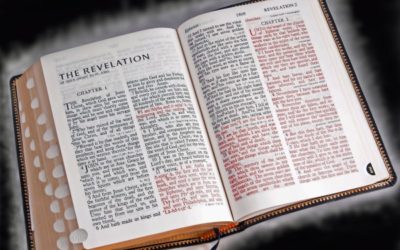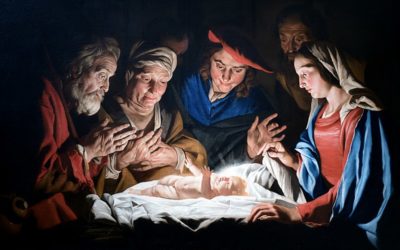The revelations that now makeup Doctrine and Covenants sections 129 to 132 were received in 1843, a period in which Joseph Smith, anticipating his death, felt the urgency of completing the Restoration and passing on doctrines he may have known for some time but hesitated to share because the first-generation Church members of his day were so steeped in the religious traditions from which they came. All four of these revelations relate to what would later be taught to Church members when they entered the Nauvoo Temple.
Doctrine and Covenants 129
On February 9, 1843, Joseph Smith gave some instructions to people gathered at his home. William Clayton recorded the instructions, which were later excerpted to form section 129 of the Doctrine and Covenants. Section 129 deals with how to tell the difference between heavenly and hellish beings. Angels who are “resurrected personages” have “bodies of flesh and bones” (verse 1). If you extend your hand, you will be able to feel the angel’s if extended in turn to you (verse 4). If the being who appears is a righteous spirit not yet resurrected, the being “will not move” if you extend your hand “because it is contrary to the order of heaven for a just man to deceive, but he will still deliver his message” (verse 7). But if the being is “the devil” appearing to you “as an angel of light, when you ask him to shake hands he will offer you his hand, and you will not feel anything; you may therefore detect him” (verse 8). This, Joseph Smith explained is how “you may know whether any administration” from a nonmortal being “is from God” (verse 9).
For William Clayton’s journal entry recording the instruction, click here.
Doctrine and Covenants 130
During a visit to Ramus, Illinois, on April 2, 1843, Joseph gave inspired instruction that was recorded by Willard Richards and William Clayton and has been excerpted as section 130 of the Doctrine and Covenants.
Joseph explained that “when the Savior shall appear we shall see him as he is” and “that he is a man like ourselves” (verse 1).
When we are with the Savior, as we will be in the eternal worlds, “that same sociality which exists among us here will exist among us there, only it will be coupled with eternal glory, which glory we do not now enjoy” (verse 2). This extraordinary statement cannot be entirely understood without contemplating how things differ in the eternities.
For example, in the eternities, we will be with loved ones who have already passed away or who are not yet born today. There will be no time as we know it now (Rev. 10:6; D&C 88:110). Money will not be a problem since the exalted will receive all the Father has (D&C 84:38). Presumably, we would share as well in God’s omniscience. These differences and others will certainly make our sociality—the way we connect and live with one another—much more glorious than what we experience today. Later in 1843, Joseph would say that if you “could you gaze in heaven 5 minute[s,]” you would learn more “than you possibly . . . can know by read[ing] all that ever was writt[e]n on the subject.”
In the instructions Joseph gave that now make up section 130, he spoke about the nature of God (verses 3, 21‒23), the reckoning of time (verses 4‒5), and where angels live (verses 5‒7).
God and the angels with him reside on “a great Urim and Thummin,” “a globe like a sea of glass and fire, where all things for their glory are manifest, past, present, and future, and are continually before the Lord” (verses 7‒8).
Our earth, “in its sanctified and immortal state,” also “will be made like unto crystal and will be a Urim and Thummim to the inhabitants who dwell thereon, whereby all things pertaining to an inferior kingdom, or all kingdoms of a lower order, will be manifest to those who dwell on it; and this earth will be Christ’s” (verse 9). Those who reach the celestial kingdom will be given the means “whereby things pertaining to a higher order of kingdoms will be made known” as well (verses 10‒11).
While giving his instructions, Joseph (verses 12‒13) recounted his revelation of December 25, 1832, that is now section 87 of the Doctrine and Covenants. He also recounted a revelation that came to him while he was “praying very earnestly to know the time of the coming of the Son of Man” (verse 14 of section 130). A voice told him, “Joseph, my son, if thou livest until thou art eighty-five years old, thou shalt see the face of the Son of Man; therefore let this suffice, and trouble me no more on this matter” (verse 15).
The answer wasn’t as definitive as Joseph wanted. “I was left thus, without being able to decide whether this coming referred to the beginning of the millennium or to some previous appearing, or whether I should die and thus see his face,” Joseph said. “I believe the coming of the Son of Man will not be any sooner than that time.” (Verses 16‒17.) Joseph, of course, died well before reaching age eighty-five.
Two other instructions Joseph gave on this occasion in Ramus have become favorites among Latter-day Saints. Verses 18‒19 explain that the intelligence we gain in this life goes with us to the next, and verses 20‒21 explain that we obtain blessings by obeying the laws upon which they are predicated.
For Willard Richards’s notes on Joseph’s instruction, click here. For William Clayton’s, click here.
Doctrine and Covenants 131
During another visit to Ramus—this one on May 16‒17, 1843—Joseph gave additional instructions, which were recorded by William Clayton and later extracted to become section 131 of the Doctrine and Covenants.
The first four verses of the section build on Doctrine and Covenants 76 by explaining that “in the celestial glory there are three heavens or degrees; and in order to obtain the highest, a man must enter into this border of the priesthood [meaning the new and everlasting covenant of marriage]; and if he does not, he cannot obtain it. He may enter into the other, but that is the end of his kingdom; he cannot have an increase.” These verses make it clear that sealing of husband and wife for eternity is necessary to reach the highest kingdom.
Verse 5 of section 131 clarifies that the “more sure word of prophecy” mentioned in 2 Peter 1:19 in the New Testament “means a man’s knowing that he is sealed up unto eternal life, by revelation and the spirit of prophecy, through the power of the Holy Priesthood.” Verse 6 clarifies that “it is impossible for a man to be saved in ignorance.” This suggests that those who have never heard the doctrines of salvation and exaltation will need to hear them at some point in order to enjoy the greatest blessings God has to offer. Section 138 of the Doctrine and Covenants explains how this can happen.
Verses 6—8 of section 131 explain that “there is no such thing as immaterial matter.” Instead, “all spirit is matter, but it is more fine or pure, and can only be discerned by purer eyes. We cannot see it; but when our bodies are purified we shall see that it is all matter.”
For William Clayton’s notes that underlie this section, click here, here, and here.
Doctrine and Covenants 132
The headnote to section 132 of the Doctrine and Covenants explains that it was “recorded July 12, 1843” and deals with “the new and everlasting covenant, including the eternity of the marriage covenant and the principle of plural marriage.”
Eternity of the Marriage Covenant
As Joseph was scrambling during the final years of his life to restore the key laws and ordinances of the gospel, he revealed the full endowment ordinance and the ordinance of sealing husbands and wives for time and eternity. The revelation that is now section 132 states this doctrine of sealing more clearly than any other. Verse 7 explains that all covenants must be (1) made by proper authority and (2) “sealed by the Holy Spirit of promise.” Otherwise, they “are of no efficacy, virtue, or force in and after the resurrection from the dead; for all contracts that are not made unto this end have an end when men are dead.”
By Proper Authority
The revelation makes it clear that to be eternally valid, a marriage must be performed “by me” (verses 13—15) or “by my word” (verses 13, 15). The joining of Adam and Eve in the holy order of matrimony in the new and everlasting covenant in the Garden of Eden was presumably done “by me” (see Genesis 2:18, 22—25), meaning by God Himself. God’s servants, speaking “by my word” with proper authority, can also perform marriages that are sealed on heaven and earth (Doctrine and Covenants 128:8), which is the way husband-wife sealings are performed in temples today.
Sealed by the Holy Spirit of Promise
But it is not enough for a marriage to be performed by proper authority. Those joined in the holy order of matrimony must live worthy of having their covenants “sealed by the Holy Spirit of promise” (Doctrine and Covenants 132:7). This is true of all the ordinances required for eternal life, including the baptismal and endowment covenants. Those who keep their covenants, repenting when they do wrong, can have the seal of the Spirit that makes and keeps the sealing valid for eternity.
The Principle of Plural Marriage
Section 132 also deals with plural marriage, a topic too complex to be covered in its entirety here. The Church has published Gospel Topics essays on the subject that can be accessed here.
Plural marriage has received a great deal of attention both inside and outside of the Church almost from the Church’s beginning to the present time. Despite the Manifesto of 1890, the topic remains current today because many Church members, especially women, worry that they will have to enter plural relationships in the next life.
The most authoritative recent talk mentioning the topic is the October 2019 general conference address of President Dallin H. Oaks titled “Trust in the Lord.” In it, he says:
“Trust in the Lord is a familiar and true teaching in The Church of Jesus Christ of Latter-day Saints. . . . That same principle applies to unanswered questions about sealings in the next life or desired readjustments because of events or transgressions in mortality. There is so much we do not know that our only sure reliance is to trust in the Lord and His love for His children.”
We can trust that loving Heavenly Parents will not want any of their children to be in any relationship they don’t want. Otherwise, heaven would not be heaven.
Credit for image at top of page: Stock image from depositphotos.com.



